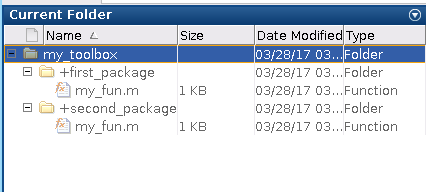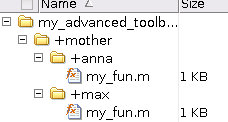About Packages¶
Did you ever think that the Path system of Matlab is not that good? Do you think, it is annoying that you always need to add a prefix (like ft_ or obob_) to your functions because otherwise there might be more than one function sharing the same name which creates chaos?
Packages are here to help you!
What is a “Package”?¶
A Package is a folder that start with a +. Everything coming afterwards is the name of the package. Function you put inside of a folder starting with a + are part of that package.
Take a look here:

You see a folder called my_toolbox. This could be a parent folder for a new toolbox you are writing. In order to use your new toolbox, people are supposed to only add this parent folder.
Inside, you find two packages: first_package and second_package. Each of these packages has a function called my_fun.m.
You can see that both functions have the same name. This would not work normally. The trick here is that both functions are in separate packages!
How do I call a function in a package?¶
Packages are available as soon as the parent folder of the package is in the Matlab path. So, in our case, we just need to add my_toolbox to the Matlab path in order to be able to access both packages:
restoredefaultpath
addpath('my_toolbox');
Now we can call our functions like this:
first_package.my_fun();
second_package.my_fun();
So, we write the name of the package first, the put a dot (.) and then the name of the function. Easy, isn’t it?
More stuff you need to know about packages¶
There is a bit more you need to know how packages work:
Packages can be nested¶
You can have packages that live inside of other packages. Like here:

Calling function in sub-packages is quite straight forward:
mother.anna.my_fun();
mother.max.my_fun();
You always need to call functions in packages with all the packages¶
Ok, sounds weird at first. Here is the thing. Even if you call a function that lives in the same package as the function calling it, you need to write all the packages.
For example: In the code, you will find two more function in the mother.anna package: add_numbers and my_other_fun. my_other_fun wants to call add_numbers.
This would not work:
function my_other_fun()
result = add_numbers(1, 3);
fprintf('One and three is: %d\n', result);
end
But this does:
function my_other_fun()
result = mother.anna.add_numbers(1, 3);
fprintf('One and three is: %d\n', result);
end
Finally¶
Play around with the package system. Write your own small toolbox and try to get the grip of it!